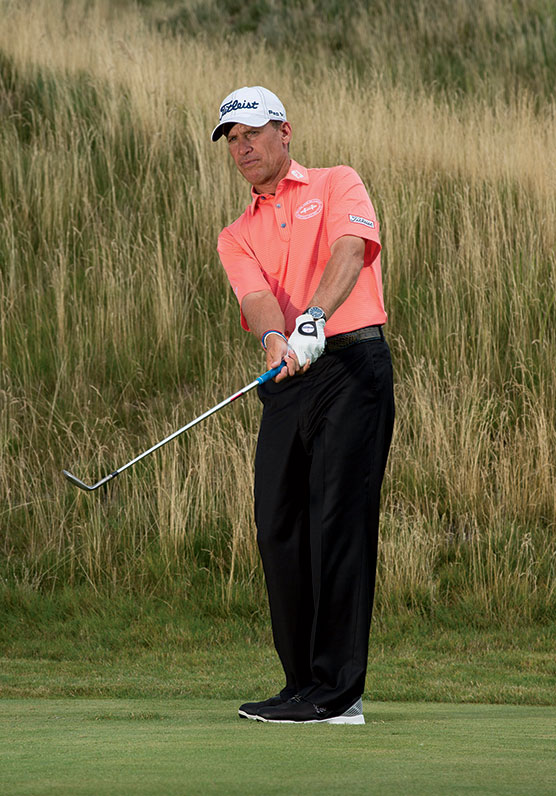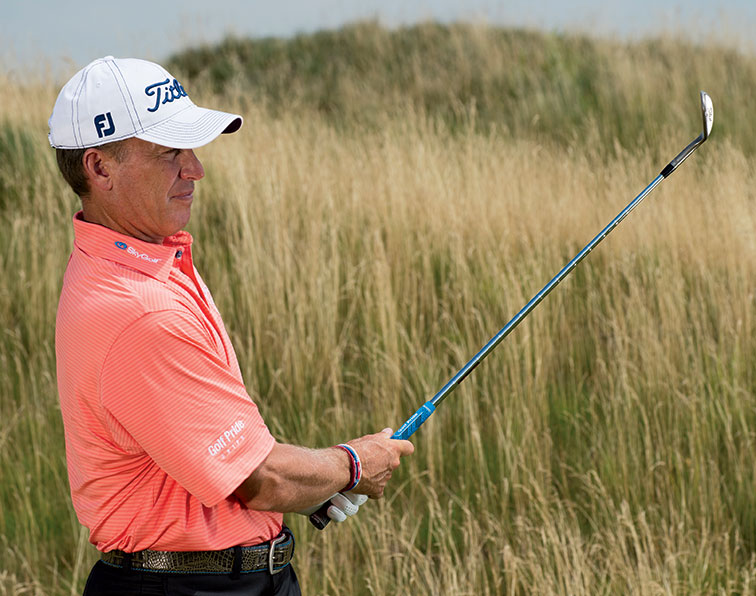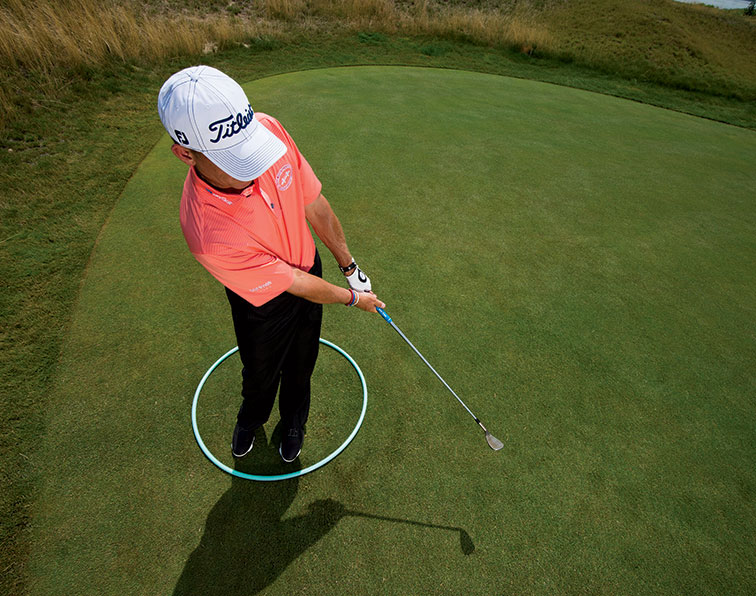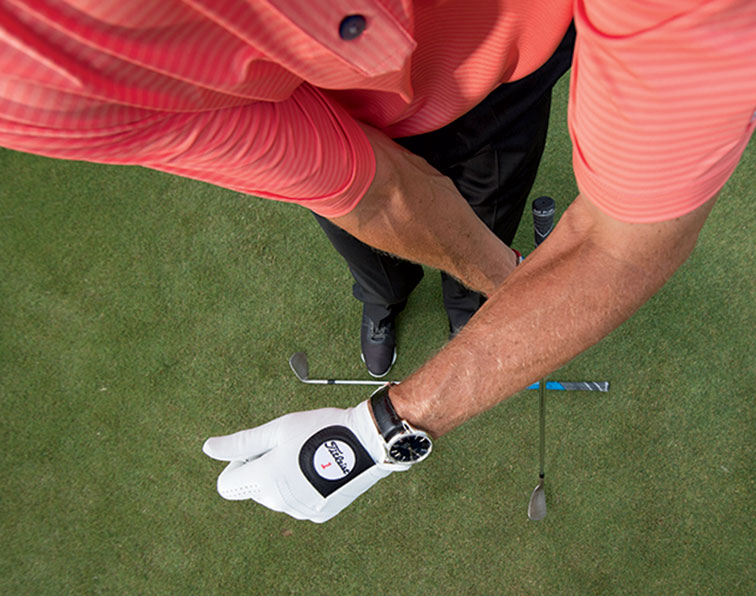Let me guess: You have trouble making solid contact on simple chips and pitches. Seems ridiculous, right? You’ve played enough golf that you should own these little shots. But you don’t. And you know what – neither does just about every amateur golfer out there.
Why is this? It’s not hard to explain, actually. Hitting these shots fat or thin means the low point of your swing arc is coming behind the ball. You’re bottoming out too soon. That much you might know. What I bet you don’t know is, that low point falls back because of something you probably try to do: Swing your hands out towards the target. It’s logical enough. You want to hit the ball there, so you swing your hands there. But that move is destroying your short game.
I’ll explain what happens in a minute, but I don’t want to wait to tell you how easy this is to fix. All you have to do to start making perfect contact is swing the grip end of the club to the left through impact, towards your left hip. If you do that, the swing bottom moves in front of the ball so you catch it on the downswing for a crisp strike. It also helps you maintain the loft on the clubface for a predictable trajectory and roll. And as you’ll see, the more you swing the handle left, the higher you hit the ball.
I know it sounds simplistic, but it works – and we’ll look at why. But one more thing: If you fight a slice in your full swing, you already swing the club the way I want you to. You’re steep into the ball and swinging left through impact. That’s the secret to a great short game. — with Peter Morrice NO
NO
– Why This Swing Doesn’t Work [above]
This is the swing most golfers make on short shots: a push towards the target. Picture you’re in your setup holding a Hula-Hoop at a 45-degree angle so it touches the ground where the ball would be. Now shift the hoop so it’s angled to the right and notice the point where it meets the ground moves back. That’s what happens if you push the handle out instead of letting it swing inside. It drops the low point back so you hit shots fat or thin.
When the handle swings straight through impact, the clubhead actually goes to the right. That’s because the hands swing on a smaller arc around the body than the clubhead does; it takes longer for the clubhead to turn left. Pushing the handle towards the target might feel straight, but it’s forcing the clubhead to the right. If you happen to catch the ball solid, you’ll hit it right. But the big issue is the low point, which is behind the ball.
 YES
YES
– Why This Swing DOES Work [above]
I understand the instinct to swing the clubhead out towards the target – you’re trying to hit the ball straight. But to move the clubhead straight through impact, you have to swing the handle to the left. Because of the angle of the shaft to the ground and the bigger arc the clubhead makes around your body, the clubhead is always moving more to the right than the handle is. To swing it straight, the handle has to go left [below].
The other thing swinging the handle left does is make the swing steep, then shallow – and that’s what you want in the short game. It’s steep coming down and then shallows out as it goes through. Picture this: When your hands get back in front of your belt buckle on the downswing, if they start pulling left, the bottom of the shaft kicks outward and moves the clubhead out over the target line. To keep the clubhead tracking down that line, the handle has to continue going left. That’s how you hit the ball solid and straight.
- Exit Left To Hit It Straight
The more you swing the handle to the left through impact, the higher the ball goes. Why? When the handle moves abruptly to the left, the loft on the clubface increases because the shaft is not leaning towards the target as much as when the handle goes farther down the line. More left equals more loft. Consider this image: You’re driving down a highway and you have three consecutive exits on the left. If the handle takes the first exit, an abrupt left turn, the shot goes the highest. If it takes the middle exit, you hit a standard shot. The third left is the lowest shot. It’s a great visual.
 HOW TO
HOW TO
– The Setup And Swing For High And Low Shots [above]
First, let’s look at ball position. There is no absolute here, but I’m sure you want to know where to play the ball. As a rule, I like it in the middle. I also like a square stance, with the toes parallel to the target line. Most golfers stand open on greenside shots, and that’s usually a reaction to the ball going right when they try to swing straight.
How high you hold the handle is the critical setup element. If you hold it high, you set up a low shot because you promote a more gradually curving swing arc – picture the handle tracing the shape of an oval. That gradual arc produces a little forward lean of the shaft at impact (and less loft) for a lower flight. If you set the handle lower, you pre-set a more circular swing arc. That abrupt arc produces less shaft lean at impact for a higher shot.
The backswing shape and wrist hinge – two commonly discussed factors – are not critical. No matter your backswing position, if you pull the handle left coming down, the clubhead is thrown into a position where it can come down sharply on the ball. Only the length of the backswing is important, as that determines how far or high you hit the shot.
So focus on handle height. High handle for low shots; low handle for high shots. If you lower the handle, adjust your body to accommodate the club: Widen your stance, bend your knees more. Let the clubhead find its balance as you lower the handle – the face will open. Whatever handle height you start with, feel as if you maintain it as you swing.
In short, a lower handle naturally swings through more to the left. Seve Ballesteros used to call this quick-left exit “putting it in the holster” because the butt of the grip ends up near the left-front pocket.
 DRILLS
DRILLS
– Swing Your Hands On A Hula-Hoop [above]
Let’s take a breath here. I realise this is a departure from the way you think about short-game shots. That’s why practice drills are important. You have to get out of the habit of swinging the handle in the same direction you want to hit the ball. Once you do that, your short game will improve immediately.
Here’s a great drill for practising the motion required to hit a high pitch shot. Place a Hula-Hoop on the ground and stand inside it with your toes close to the hoop. Make some slow practice swings watching your hands track along the circular arc going through. This is a pretty abrupt radius for the swing, so this motion will produce a quick-left exit, the kind that leads to a higher ball flight.

– Block The Straight Swing [above]
Try this drill to groove the basic motion of exiting left. Grip a wedge in your right hand only and hold out your left arm at about a 30-degree angle to your stance line. Practise swinging the club back and through without bumping into your left arm. The arm is a barrier that will force you to swing the handle in towards your body rather than out towards the target on the through-swing. You’ll feel the club “turning the corner” to the left.
- Learn To Park It In The Garage
What’s great about this instruction is, it gives you a destination for the swing, an end point. With any swing, if you can get in the correct position at the finish, you’ll do a lot of things well without thinking about them. Years ago I played at Augusta National with Raymond Floyd, who was the best of his time around the greens. He told me he thought a lot about sticking the finish, called it “parking the car in the garage.” I love that. If you think about parking the handle to the left, you’ll make consistent contact and have a dream short-game.
– Michael Breed hosts “The Golf Fix” on Golf Channel and teaches at Trump Golf Links at Ferry Point in New York City.

